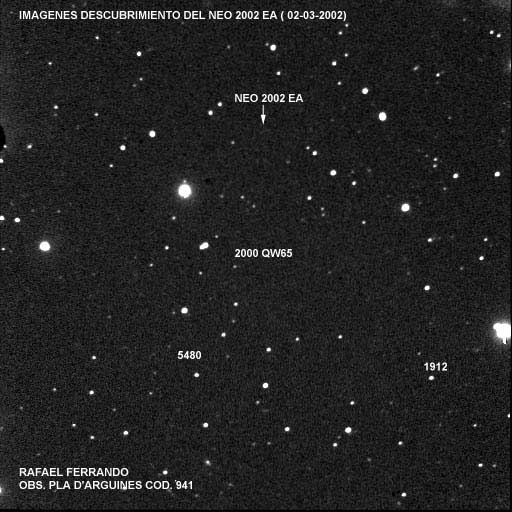
The discovery of 2002 EA
The First Spanish NEA Discovery
Rafael Ferrando
Observatorio Pla D'Arguines
(IAU Site Code 941)
Castellón, Spain
On March 2nd 2002, as usual on observing nights I prepared to take exposures of various comets, supernovae and asteroids with my 12-inch (30cm) LX-200 telescope and ST9-E CCD. After taking some images of various comets (P/2001 TU80 (LINEAR-NEAT), C/2002 C2 (LINEAR), and C/2001 C1 (Ikeya-Zhang) and the supernova Sn 2002ap, I started to take recovery measurements of asteroids that have just a few days of observing arc in their first opposition. This work is very important because many of these asteroids would be lost if they could not be recovered in their second opposition and thus their orbit would not be well determined.
The first field that I observed was of 2000 QW65, a main belt object observed over an arc of 2 months in 2000. This field also included two numbered asteroids: the rather poorly observed 1912 (Annubis) and the unnamed asteroid 5480 (1989 YK8).
In this field I noticed a faint trail. Although this might just have been noise in the CCD, there was also the chance that it could be a NEO, so I took another exposure. When this second exposure appeared I blinked the two to see if the mystery object reappeared and if it moved between them. On doing this it appeared possible that it could be a NEO, so I took two more exposures.
While exposing, I checked the Minor Planet Center (MPC) computer and discovered that there is no known NEO in this position. On finding this, my heart leapt into my mouth and my pulse raced. Conscious of the potential importance of the discovery I took astrometry of the exposures and sent it to the MPC. Within seconds the MPC answers asking me to follow this object as long as possible as it appears to be a NEO.
The NEO confirmation page at the MPC automatically generated an announcement with the positions that I had supplied, requesting other observatories to confirm it. At the same time, I contacted my colleague, Pepe Manteca at Begues (IAU Site Code 170), and we sent an urgent notification to the Spanish language comet observers mailing list called "Cometas_Obs" (Cometas_Obs@yahoogroups.com) in the hope that another Spanish observatory could confirm it, although bad weather in much of Spain made this seem unlikely.
I was able to follow the object from my observatory for almost 5 hours, although fog and cloud started to appear and made the object difficult to observe. As each exposure came off the CCD it was measured and sent to the MPC.
The first exposure that showed the object was taken at 21:46UT and the MPC was alerted just after 21:51UT. When I had stopped observing - the last usable exposure came down from the CCD at 01:12UT - and had sent off the last set of measures I could check the NEO Confirmation Page and saw that Ondrejov Observatory in the Czech Republic had reported four measurements starting at 00:32UT, less than 3 hours after my initial report. The object was confirmed. This allowed me to sleep easier because I was in need of a few hours rest!
I went to be hoping that the weather would improve and that, on the Sunday night I could recover it. However, luck was not with me - it was cloudy and I could not observe. That night though observers from all round the world could observe, amongst them the Observatorio Astronómico de Mallorca (OAM), on the Mediterranean island of Majorca, quite close to my own observatory and one of the teams alerted by the mailing the previous night.
With two nights of observations, a provisional orbit could be calculated and a designation (2002 EA) assigned. 2002 EA was found to be an Apollo asteroid, one that crosses the Earth's orbit and thus one of the potentially most dangerous class of NEAs. Given a 15% albedo it would be about 130 meters across and will pass just behind the Earth in its orbit at about 8.5 million kilometers distance on March 15th.
Images attached:
2b-.JPG - Discovery frame of 2002 EA labeling the three other asteroids in the frame, including the target of the observation. Note how faint the track of this asteroid is.
3b-.JPG - Frame taken immediately afterwards that was used to blink the original image.
NEO2002EA-.JPG - The orbit of 2002 EA relative to the Earth showing the encounter circumstances on March 15th 2002 calculated using "The Sky" from the MPC orbit for the asteroid. Note that the approach is a tail chase and that the asteroid passes just behind the Earth.